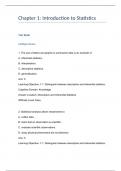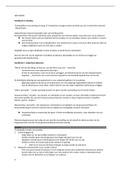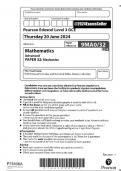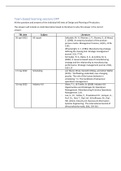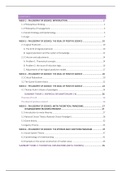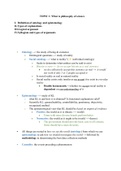Chapter 7 Media Planning
Table of Contents
1. Some key concepts
2. Why engage in media planning
3. How to select media?
3.1. Quantitative criteria
3.2. Qualitative criteria
3.3. Technical criteria
4. Media context
5. References
1. Some key concepts
Media describe the types of communication channels that can distribute a message. Vehicles are particular programs,
magazines etc within a specific medium.
A media plan is a document specifying which media and vehicles will be purchased when, at what price and with what
expected results.
2. Why engage in media planning
Since it is becoming more and more expensive to buy advertising time and space, all touch points with consumers should
be as effectively and efficiently as possible (De Pelsemacker, 2018). To attract attention of the customers, creative ads
can be distributed in several media. Selecting specific media involves setting up a media plan given a specific target
group and taking into account several criteria. Specific technical characteristics of each medium are compared as well as
quantitative and qualitative criteria. These criteria have to be considered meticulously so that advantages and
disadvantages of different media can be assessed before the specific media are chosen.
3. How to select media?
Media planning starts with the assessment of the communication environment. Which legal aspects and regulations are
applicable, which media are customers predominantly using and what are competitors doing in terms of category
spending, share of voice and media mix (De Pelsemacker et al., 2018). Depending on the media behavior of the target
group and the communication objectives, concrete, measurable and realistic media objectives are put forward. Media
objectives concern frequency, reach, weight, continuity and cost.
3.1. Quantitative criteria
Frequency indicates how many times a consumer of the target group is expected to be exposed to the advertiser’s
message (media vehicle) within a specified time period. It is an estimate and not an objective count of exposure. The
decision how many times a target group has to be reached depends on the effectiveness of ad frequency. The two-factor
model of Berlyne (1970) predicts that cognitive responses, attitudes and purchases wear in and wear out with increasing
exposures. New stimuli can evoke counterargumentation and need some exposure to evoke positive reactions (cfr. Mere
exposure). Repetition increases learning and reduces uncertainty. However, more frequent exposures lead to negative
reactions due to boredom and irritation. Excessive exposures can lead to advertising wear-out, which can result in
negative reactions to an ad after seeing it too much. Marketers have to balance familiarity with a repeated message with
boredom from repeating the message. Too much exposure can create habituation, whereby the consumer does not pay
attention anymore. The two-factor theory combines the positive learning factor and the negative tedium factor showing
that at some point, the amount of boredom begins to exceed the amount of uncertainty reduced, resulting in wear-out.
Effective frequency is then the minimum number of exposures, within a purchase cycle, considered necessary to motivate
a customer to act or at least form a positive attitude. Different researchers show different optimal effective frequency
1
Table of Contents
1. Some key concepts
2. Why engage in media planning
3. How to select media?
3.1. Quantitative criteria
3.2. Qualitative criteria
3.3. Technical criteria
4. Media context
5. References
1. Some key concepts
Media describe the types of communication channels that can distribute a message. Vehicles are particular programs,
magazines etc within a specific medium.
A media plan is a document specifying which media and vehicles will be purchased when, at what price and with what
expected results.
2. Why engage in media planning
Since it is becoming more and more expensive to buy advertising time and space, all touch points with consumers should
be as effectively and efficiently as possible (De Pelsemacker, 2018). To attract attention of the customers, creative ads
can be distributed in several media. Selecting specific media involves setting up a media plan given a specific target
group and taking into account several criteria. Specific technical characteristics of each medium are compared as well as
quantitative and qualitative criteria. These criteria have to be considered meticulously so that advantages and
disadvantages of different media can be assessed before the specific media are chosen.
3. How to select media?
Media planning starts with the assessment of the communication environment. Which legal aspects and regulations are
applicable, which media are customers predominantly using and what are competitors doing in terms of category
spending, share of voice and media mix (De Pelsemacker et al., 2018). Depending on the media behavior of the target
group and the communication objectives, concrete, measurable and realistic media objectives are put forward. Media
objectives concern frequency, reach, weight, continuity and cost.
3.1. Quantitative criteria
Frequency indicates how many times a consumer of the target group is expected to be exposed to the advertiser’s
message (media vehicle) within a specified time period. It is an estimate and not an objective count of exposure. The
decision how many times a target group has to be reached depends on the effectiveness of ad frequency. The two-factor
model of Berlyne (1970) predicts that cognitive responses, attitudes and purchases wear in and wear out with increasing
exposures. New stimuli can evoke counterargumentation and need some exposure to evoke positive reactions (cfr. Mere
exposure). Repetition increases learning and reduces uncertainty. However, more frequent exposures lead to negative
reactions due to boredom and irritation. Excessive exposures can lead to advertising wear-out, which can result in
negative reactions to an ad after seeing it too much. Marketers have to balance familiarity with a repeated message with
boredom from repeating the message. Too much exposure can create habituation, whereby the consumer does not pay
attention anymore. The two-factor theory combines the positive learning factor and the negative tedium factor showing
that at some point, the amount of boredom begins to exceed the amount of uncertainty reduced, resulting in wear-out.
Effective frequency is then the minimum number of exposures, within a purchase cycle, considered necessary to motivate
a customer to act or at least form a positive attitude. Different researchers show different optimal effective frequency
1


